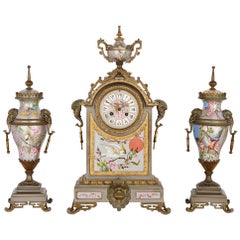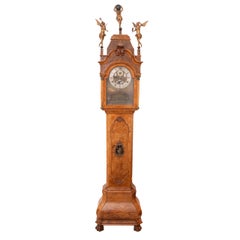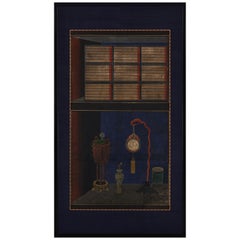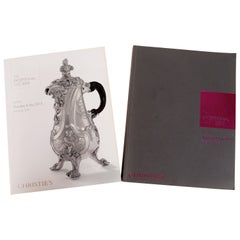Chinese Porcelain Clock
Antique Late 19th Century French Chinese Export Mantel Clocks
Brass
Antique 19th Century Dutch Rococo Revival Clocks
Walnut
Antique Late 19th Century Korean Edo Paintings and Screens
Paper
21st Century and Contemporary English Books
Paper
Recent Sales
Antique 18th Century and Earlier Chinese Rococo Clocks
Bronze
Antique 1830s Chinese Chinese Export Mantel Clocks
Brass, Steel
Antique Late 19th Century French Louis XV Table Clocks and Desk Clocks
Bronze
Antique Late 19th Century Chinese Clocks
Ormolu
Antique Late 19th Century French Japonisme Mantel Clocks
Bronze
Antique 19th Century Chinese Mantel Clocks
Ormolu
Antique Late 19th Century French Napoleon III Mantel Clocks
Bronze
Antique Late 19th Century Chinese Rococo Revival Table Clocks and Desk C...
Bronze
Antique 19th Century Chinese Clocks
Brass
Antique 19th Century Chinese Ceramics
Porcelain
People Also Browsed
Early 20th Century Japanese Meiji Cabinets
Iron
Early 20th Century Austrian Arts and Crafts Chandeliers and Pendants
Metal, Brass, Wire
Antique Late 19th Century Chinese Qing Furniture
Elm, Reed
2010s Italian Wallpaper
Paper
Vintage 1970s Mid-Century Modern Chairs
Paper
Early 20th Century French Arts and Crafts Chandeliers and Pendants
Brass, Metal
Antique 19th Century French Louis XVI Children's Furniture
Giltwood
2010s South African Ottomans and Poufs
Velvet
Antique 19th Century French Rococo Screens and Room Dividers
Giltwood
Antique Early 1900s English Chinese Chippendale Grandfather Clocks and L...
Wood
Early 2000s British Modern Chandeliers and Pendants
Crystal, Chrome
Early 20th Century Italian Rococo Bird Cages
Metal
2010s Italian Cabinets
Brass
Antique 17th Century Japanese Figurative Sculptures
Metal, Iron
Vintage 1980s American British Colonial Chaise Longues
Leather
Antique 15th Century and Earlier English Renaissance Beds and Bed Frames
Oak
Chinese Porcelain Clock For Sale on 1stDibs
How Much is a Chinese Porcelain Clock?
Finding the Right Decorative Objects for You
Every time you move into a house or an apartment — or endeavor to refresh the home you’ve lived in for years — life for that space begins anew. The right home accent, be it the simple placement of a decorative bowl on a shelf or a ceramic vase for fresh flowers, can transform an area from drab to spectacular. But with so many materials and items to choose from, it’s easy to get lost in the process. The key to styling with antique and vintage decorative objects is to work toward making a happy home that best reflects your personal style.
Ceramics are a versatile addition to any home. If you’ve amassed an assortment of functional pottery over the years, think of your mugs and salad bowls as decorative objects, ideal for displaying in a glass cabinet. Vintage ceramic serveware can pop along white open shelving in your dining area, while large stoneware pitchers paired with woven baskets or quilts in an open cupboard can introduce a rustic farmhouse-style element to your den.
Translucent decorative boxes or bowls made of an acrylic plastic called Lucite — a game changer in furniture that’s easy to clean and lasts long — are modern accents that are neutral enough to dress up a coffee table or desktop without cluttering it. If you’re showcasing pieces from the past, a vintage jewelry box for displaying your treasures can spark conversation: Where is the jewelry box from? Is there a story behind it?
Abstract sculptures or an antique vessel for your home library can draw attention to your book collection and add narrative charm to the most appropriate of corners. There’s more than one way to style your bookcases, and decorative objects add a provocative dynamic. “I love magnifying glasses,” says Alex Assouline, global vice president of luxury publisher Assouline, of adding one’s cherished objects to a home library. “They are both useful and decorative. Objects really elevate libraries and can also make them more personal.”
To help with personalizing your space and truly making it your own, find an extraordinary collection of decorative objects on 1stDibs.
- 1stDibs ExpertApril 5, 2022Chinese Canton porcelain is a type of decorative hand-painted ceramic ware produced during the 18th, 19th and 20th centuries in China. Its name comes from the region where it originated. You will sometimes see it referred to as Cantonese porcelain. On 1stDibs, find a selection of Chinese Canton porcelain.
- 1stDibs ExpertApril 5, 2022A Chinese porcelain pillow is a type of ceramic object produced by Chinese artisans. They normally have highly decorative rectangular designs and feature curved tops. Historically, they functioned as headrests, but today they normally serve purely as decorations. On 1stDibs, shop a wide variety of Chinese porcelain ware.
- What is Chinese porcelain called?2 Answers
 PAGODA REDOctober 7, 2020
PAGODA REDOctober 7, 2020True porcelain ware was developed in the 11th century at the imperial kilns of Jingdezhen, Jiangxi province, China. These early porcelains of the Song and Yuan dynasties are known as Qingbai or Yingqing ware, defined by a light blue-grey glaze. Later forms of Chinese porcelain include blue and white underglaze ware, Celadon ware, Jun ware, Famille Verte ware, Wucai (Five Color) ware, and Dehua ware, also known as Blanc de Chine.
 Lotus GalleryMarch 17, 2021In China, porcelain is referred to a "cíqì" 瓷器.
Lotus GalleryMarch 17, 2021In China, porcelain is referred to a "cíqì" 瓷器.  Lotus GallerySeptember 15, 2020
Lotus GallerySeptember 15, 2020Chinese porcelain can usually be dated by form and decoration. However, copies and forgeries abound, so you should have an expert such as an appraiser, reputable dealer or auction house, or museum examine your porcelain to accurately date it.
- 1stDibs ExpertApril 5, 2022To identify Chinese export porcelain, first look for a mark. Most pieces made after 1891 feature a maker's mark that you can research using authoritative online resources. Identifying older porcelain ware is more difficult. A licensed appraiser can provide assistance. You'll find a range of expertly vetted Chinese export porcelain on 1stDibs.
- 1stDibs ExpertApril 5, 2022You can sell old Chinese porcelain in a few ways. You can advertise the piece locally or work with an antique shop or auction house. There are also reputable online platforms available for selling online. Shop a collection of Chinese porcelain on 1stDibs.
- 1stDibs ExpertApril 5, 2022Chinese blue and white porcelain is the most common type of decorated porcelain. Its name in Chinese is qinghua. On 1stDibs, you’ll find a collection of antique and modern Chinese blue and white porcelain from some of the world’s top sellers.
- 1stDibs ExpertApril 5, 2022Chinese Kangxi porcelain was popular because of its particular blue colorings. The blue was made using cobalt ore which was imported from Persia. As cobalt ore was a scarce ingredient, the rarity made the porcelain items highly sought after. Shop a collection of Chinese Kangxi porcelain from some of the world’s top sellers on 1stDibs.
 PAGODA REDOctober 21, 2020
PAGODA REDOctober 21, 2020For thousands of years, China’s court-sponsored porcelain industry has been at the forefront of technical innovation and aesthetic refinement. Exquisite finishes and precision of form gave China an international reputation for fine ceramic wares. Age, shape, glaze, motif, and reign mark are all factors contributing to the value of a ceramic piece, indicative of the maker and the dynastic reign under which the object was created.
- 1stDibs ExpertAugust 20, 2024To identify Chinese porcelain marks, consult trusted online resources. Most markings on Chinese porcelain consist of four to six characters, and the last two often represent when a piece was produced. Since there is a lot of variation in the markings, looking at images shared on trustworthy websites is the best way to make an identification. Alternatively, you can use the services of a certified appraiser or knowledgeable antique dealer. On 1stDibs, explore a wide range of Chinese porcelain.
 Lotus GallerySeptember 23, 2020
Lotus GallerySeptember 23, 2020The best way to know is to take it to an expert, such as an appraiser, reputable dealer or auction house, or museum
- 1stDibs ExpertMarch 22, 2022Chinese blue and white porcelain is called qinghua, pronounced “CHING-hwa.” Artisans first began producing the porcelain during the Tang and Song dynasties ranging from 609 to 1279. However, the techniques the pottery is most well known for weren't developed until the subsequent Ming era, which lasted until 1644. You'll find a collection of Chinese porcelain on 1stDibs.
Read More
How a Craving for Color Revolutionized Glass
After synthetic dyes changed fashion, home goods and printed matter, it was only a matter of time till glass caught up.
Kazuyo Sejima’s Flowering Tree Blooms Year-Round
The brilliantly simple design turns a modest bouquet into a major statement.
He Wrote ‘Oedipus Rex,’ but Do You Know What He Looked Like?
The Greek tragedian is said to have been handsome in his day.
Cigar Culture Was Once the Peak of Masculinity. Now, It’s a Compelling Curiosity
Even for those who don’t indulge, elegant smoking accessories and audacious art portraying cigar enthusiasts hold a nostalgic allure.
African Travel Plans on Hold? This Ardmore Leopard Vase Brings the Beauty of the Savanna to You
It’s an excellent example of the sought-after ceramics coming out of South Africa’s KwaZulu-Natal province.
With a High-Tech Flagship and Cool Collabs, Lladró Is Breaking the Mold for Porcelain Production
Thanks to its new leadership, the Spanish maker of figurines, busts and lighting is on a mission to update the art of porcelain for the 21st century.
Zoë Powell’s Magnolia 05 Vessel Is Handmade from Clay She Unearthed Herself
The free-form stoneware piece is inspired by the magnolia tree and its associations with home.
8 Ways to Breathe New Life into a Space with Plants
The pair behind the Instagram account @houseplantclub share their tips for making any room of the house gloriously green.





